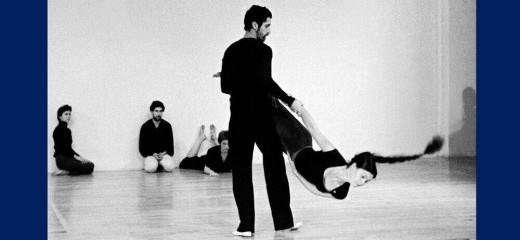
Reflections on Nancy Stark Smith, Collaborating Founder of Contact Improvisation, part 2
by Jonathan Stein
This is the second of two parts of reflections on the life and work of the late Nancy Stark Smith, this second from those across the country and London. The first part contained reflections from those in the Philadelphia area. A memorial essay from K.J. Holmes complements these reflections.
On Nancyness
by Steve Paxton
Nancy Stark Smith; you have gone. I didn't think it would end like this. But this isn't about you. It's about me. I'm all I have left of you. For 48 years, I depended on you for my supply of Nancyness accepting your various Nancy elements perhaps too casually; perhaps I didn't realize how unique, how precious the supply of Nancyness was. Yes, just a personnel flavor in my world, some more Nancyness comes my way, and now, too late I think but for you where would I get any? The world is large, and statistically there are people more or less like you. Some more, some less. But realistically none of them have the required Nancyness. I'll never feel again the precise me you made me be.
But this isn't about me. It's about we. You know how, at a funeral, there is a realization that everything that remains is in the heads and hearts of that repository we call the mourners? Memories and ashes, on we go, from May 1, 2020, for life. We will meet and speak and feel together of you, residual Nancyness, all those remains. Yes, Nancy you have gone, but obituaries are forever.
‘You always have to be ready to catch yourself’
by Elizabeth Zimmer
In the spring of 1975, I was a fledgling dance critic for the CBC radio station in Vancouver, British Columbia. One evening I was scheduled to review a concert by the Nikolais Dance Theater. Early that morning my dance teacher, Linda Rubin, called and invited me to something at the Vancouver Opera Association’s rehearsal hall; all she would tell me was that it involved Steve Paxton and Nancy Stark Smith, American improvisational performers about whom I knew nothing.
What I found there, in midafternoon, were two extraordinary movers, Cunningham alumnus Paxton and recent Oberlin grad Stark Smith, throwing each other about in the hall. And simultaneously talking, explaining the origins of their process and fielding questions from the small crowd surrounding them. Stark Smith leaped into the air and landed on Paxton’s shoulder, then slithered down his back to the floor. Every molecule of my perception of dance was altered in those moments. “Aren’t you afraid of falling off him?” I asked her.
“You always have to be ready to catch yourself,” she said. It took me close to two years, but I did eventually become their disciple. And never again had patience with Nikolais.
Contact through the screens
by karen nelson
almost a week before nancy died, two heart-friends and i were zooming from our quarantines, planning to do some tuning improvisation.
i had a sudden yearning to dance in touch, and the others agreed. we sat eyes closed on our respective floors and i guided us into the memory-imagination of resting, awkwardly, sharing contact with two backs. we began mary ganzon’s “exercise for coherence” —each taking turns describing current sensations. had you been there, you’d have felt the exchange of a shared dance. i started describing the touch of someone’s shoulder. with eyes closed i turned and saw it was nancy, wearing her green cashmere sweater, soft, fuzzy, embodied and scent-full. in our shared coherence dance, nancy eventually nestled in the space made by our three backs together.
REVOLUTION! we discovered that it is so very possible to have real contact through the screens.
And now dear nancy takes it to a whole new level. yesterday, i danced with seaweed and beach, arms swinging like a chöd drum, deer feet stepping to form a yin-yang symbol, one part lilac blooms, the other emptiness. the protection circle rhythm still sings in me, as i Let Her Go.
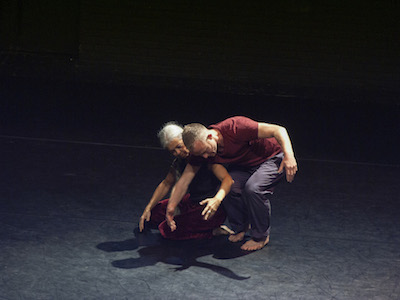
How transmission works, and sharing the key
by Paula Clements Sager
. . . I’ve recently been reading Nancy’s rich oeuvre of editor letters. In one she writes of “learning to fall by choice” and offers a question to keep us busy for a lifetime: “How can we stay awake in the fall?”
I’m glad her voice is still here speaking so directly to me, to you, to dear future readers who, in vol. 22 #1, 1997, will learn how transmission works. She recalls the first time she experienced Steve Paxton speaking the small dance as she follows “a nearly subliminal story told directly to my body.” Since then every time she taught the small dance she would quote Steve’s words and cadence verbatim, “hoping to transmit as directly as possible what I received in the expectant calm of a predawn winter day in 1972 and many times thereafter.” Her question, “How could something so little last so long?” is her hand-off to us.
Nancy’s mastery of the space-time continuum feels intimate, boundless, and completely grounded in Now. Here she is describing the period at the end of a sentence as a place, “a tiny planet on the page—mysterious and possibly inhabitable.” Rediscovering her editor letter in the Fall ’82 “Non-verbal Issue”, I stare into the blank page, soaking in her absence, a vibrating, bright presence.
In a recent exchange of memories, a friend texted me a treasured artifact from the Underscore work with Nancy. I see a big piece of canvas filled with an orderly arrangement of gestural symbols and words, glyphs and indications, prompts and gateways. It’s not a map but the Key to the map, instructions just cryptic enough to get you oriented. A way of opening things up so a path appears and you begin to see what’s already moving and oh, here we go . . .
Our very best teachers always leave their work unfinished. Nancy shared the key with so many of us around the world. What else can we do now, with love and abundant gratitude, but carry on?
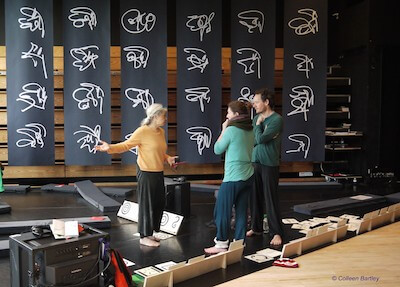
Teaching us to embrace the unknown, to be merciful and accountable
by Chris Aiken
Nancy Stark Smith is one of the most influential people I have known in my life. I knew her in many capacities. She was a role model, a mentor, a friend and a collaborator. She was one of my first contact improvisation teachers, who later became a collaborator in a performance group entitled Group Six, which included Ray Chung, Peter Bingham, Jeff Bliss and Julie Carr, as well as numerous other performances over the years, including a trio with her, Andrew Harwood and me presented by Philadelphia Dance Projects in Philadelphia in 1999. Nancy became one of my closest friends as time passed, especially in the last ten years when Angie Hauser and I moved to Northampton to teach at Smith College.
. . . I will never forget the summers of 1986-88 when I attended the Acapella Motion workshops in the Crew House studio at Smith College. These workshops were pivotal in my life, setting in motion my quest to become a professional dance artist devoted to dance improvisation. During those summers I was in awe of her physical mastery, her teaching ability, and her insatiable curiosity to learn and bring people together in ways that were not only creatively productive but spiritually and ethically grounded.
Nancy inspired me with her commitment to researching the possibilities of contact improvisation as a vehicle for expanding one’s creative and physical intelligence, as a means for becoming present to the moment, to one’s experience in all its psycho-physical complexities, and to being with others in ways that were profound, even if it was someone I had just met through dancing.
I remember being guided by her voice, speaking words that felt as if they were coming forth from the earth, teaching all of us how to live in the world with cultivated awareness, playful exploration and deep coordination with forces that were far bigger than us, such as gravity, weight, momentum, and our evolutionary ancestry. For her, poetics and survival were intertwined. At a time in my life when I had grown mistrustful of intellectualism and rhetoric, she showed me how carefully chosen words could become fulcrums for perceptual awakenings and enlightened experience. Through her teachings, she taught us to mind the gap between presence, fearful withdrawal, and mindless habit. She taught us how to change states, how to inhibit long-held patterns of behavior and how to catalyze a room full of people through well-formed and well-timed questions and images. She taught us all to embrace the unknown and not to take ourselves too seriously. She taught us to be merciful and accountable, as we coped with our failures and limitations.
Nancy is a part of me and I will cherish my memories of her forever.
Indomitable strength and spirit
by Steve Christiansen
My first interaction with Nancy Stark Smith occurred at the “birth” of Contact Improvisation. Steve Paxton had invited me to come to New York City in June of 1972 to videotape a series of performances at the John Weber Gallery, which were the first public displays of this new dance form. Steve had recruited about 20 people, including Nancy and other students from Oberlin College, and. . . spent every day rehearsing, performing, and essentially developing, the core aspects of Contact.
It was clear to me at that time that Nancy was a driving force in this creative process. She embraced the work with gusto and she seemed to be the one most willing to take physical risks and push the boundaries of movement to their extremes. This was the beginning of her lifelong immersion in Contact Improv and her role as international disseminator of the form . . .
[I]n every encounter I had with her, she was present and mindful in the moment and exhibited an indomitable strength and spirit. We have lost a radiant being, a partner in the dance of life, but her influence and compassion will linger in the world for a long time.
Containing and articulating ephemeral experiences
by Colleen Bartley
. . .A one-time performance event in 1972, Contact Improvisation has grown exponentially and is now danced on every continent and developed in a multitude of ways: socially, therapeutically, in performance, and there are even hybrid forms like Contact Tango, ParCon and trainings like DanceAbility amongst others. CI is accessible to Every Body.
Collaboration was at the heart of Nancy Stark Smith’s work….Yet she enjoyed friction and tension as positive, generative forces in dancing, conversation, and especially in the writing and editing process. She called it “the rub.” At times this could be exasperating, but I learned a lot from this aspect of her personality.
When she invited me to guest co-edit the CQ Newsletter in 2013 I observed her modus operandi echoed in all of her endeavors – attending to every detail personally, responding to thousands of emails with care and dedicating hours to considering all perspectives. She invented names for everything and mini-rituals, like banging a gong when we finished production or starting our Skype meetings with a moment of silence.
Nancy devised ways to contain and articulate ephemeral experiences and dancing states in glyph language, gestures, scores, games, words and forms like the Underscore and exercises like Speed Rainbow. She curated events and experiences to study, reflect, relate and contemplate and dive into the discipline of improvisational dance.
With her departure, we’ve only just begun to realize the scope and impact she’s had in our culture.
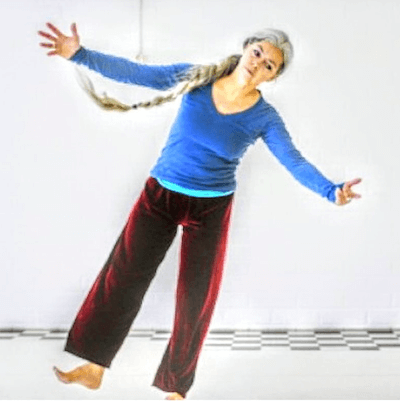
CI in the development of DanceAbility
by Alito Alessi
I first met Nancy in the early 70’s at a Contact Improvisation workshop at the Community Center for the Performing Arts in Eugene, Oregon. She had recently been working with Steve Paxton the founder. . . Nancy’s dance reflected the values of her life, and from them I learned I could dance and teach in a way that supported my beliefs and which later directly led to my developing the DanceAbility method for differently abled people.
In March of 1981 Karen Nelson and I founded the Brietenbush Contact Improvisation Jam in Detroit, Oregon, the longest running jam in the world, now in its 40th year. In the summer of 1981 Karen and I studied with Nancy at Naropa Institute where we discussed using the jam for research to maintain the roots of the CI form; Nancy’s early commitment to teach CI set a precedent. . . In 1982 Nancy organized A Capella Motion, a CI and movement arts intensive workshop meeting annually for the next ten years at Smith College in Northhampton to teach and research Contact Improvisation. The group consisted of many of CI’s most influential developers of that time including Karen Nelson, K.J. Holmes, Carol Swan, Susan Shell, Simone Forti, Christina Svane, Lisa Nelson, Andrew Harwood, Julyen Hamilton, and myself. . .
As I look back it becomes obvious that Nancy was the seminal person who created a circle of people who grew up together with their roots in Contact Improvisation, and going on to develop our own work that has spread globally. No one, however, has had the impact and brought more people into the sphere of CI then Nancy Stark Smith. Thank you Nancy, for the legacy you leave.
Daring young women challenging the physicality of femininity
by Nita Little
It is interesting to note that grief can be both personal and public, for oneself, and for others. Rarely does that include a whole world, as it does with Nancy Stark Smith. My grief for her seems to be all of those things, sometimes simultaneously, growing out of the core of what I experienced of her as a sister in the birth and growth of Contact Improvisation. . .
The ground of this deep familiarity had been well laid through the early years of Contact Improv and the way our female bodies believed in one another enough to seek out unknown territories. We knew each other as daring young women challenging the physicality of femininity and seeking new relationships with our bodies – and all bodies. We didn't do it alone, of course, Steve Paxton was the provocateur, but we showed up to test the waters of what women in dance could do, what beauty could be, where grace could be known, and with whom. We owned our bodies and were coming to realize that in moving we were so very much more than simply the flesh forms we contained. It was as if we stepped onto stage and invited all eyes to penetrate us down to our earthly essence in the physics of motion and the relations of our stars, within. Once known, this bond could never be broken no matter how time and space move on. . .
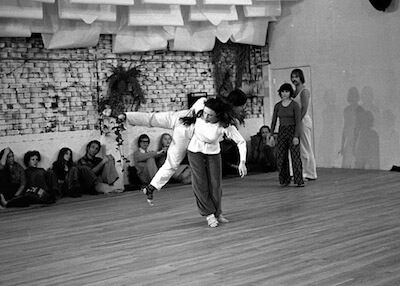
Sacred work of articulating bodily experience into language
by Meredith Bove
My time working at CQ as Associate Editor with Nancy Stark Smith happened to align with her diagnosis of ovarian cancer, and the subsequent two years during which she was undergoing treatment. . . I witnessed Nancy's superhuman amounts of strength, reserve, and commitment in action, as she indefatigably laid her hands on every draft of every page of each [CQ] issue, sometimes much to my chagrin. . . yet her care and attention to editorial process and production gave me a new level of understanding of the term "detail-oriented.” Thanks to Nancy, I now more than ever, believe that god (or spirit, or the holy, or the sacred, or the transcendent) is truly in the details.
Which is to say, that Nancy taught me something about the sacredness of this work—namely, articulating bodily experience into language, and of being in exchange with and in relationship to each other by way of editorial process. Through her leadership at CQ and her devotion to the written word, Nancy has left a legacy that validates all of our needs for the experience of embodiment to be communicated and understood.
In seeking to honor and be accountable to Nancy’s legacy, I want to try, try again, and then try harder for the following: connection, dialogue, and exchange with community; honing an articulation of dancing experiences and experiments in order to be in relationship to each other and the world; and lastly and importantly, holding profound humor, play, lightness, and curiosity alongside a steadfast belief that our work is serious and matters.
Inextricably woven into my memories of our hard work together is Nancy’s eruptive laugh, bright smile, and mischievous wit. Thank you Nancy for the improvisation, for your storytelling, and for highlighting what matters most.
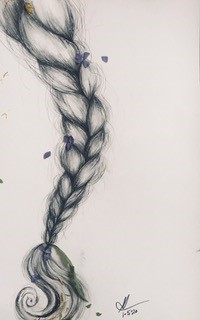
(Another set of reflections on Nancy Stark Smith and a memorial essay by K.J. Holmes also appear in thINKingDANCE.)
For more background on the work of Nancy Stark Smith see:
Stark Smith website: www.nancystarksmith.com
Contact Quarterly: www.contactquarterly.com
Global Underscore: www.globalunderscore.com
For video of Stark Smith performing, and in workshops and talks see:
Poetics of Touch (video by Sara Pozzoli & Germana Sicilliani, Casina Settarte, Italy, 2007) (https://www.youtube.com/watch?v=v6Pt0OXK7es)
Global Underscore, 2014 Warsaw flow, Intern’l Dance Contact Improvisation Festival (https://www.youtube.com/watch?v=oOGLMZdm2uA)
“An emerging underscore—A conversation with Nancy Stark Smith,” (interview in London, 2012) (https://www.youtube.com/watch?v=gzG609NWp1Y)
Performance with Mike Vargas, Andrew Harwood, Ray Chung and Nancy Stark Smith (https://www.youtube.com/watch?v=xaCZvIbl860)
Nancy Stark Smith Introduction to Fall After Newton (1987 film) (https://www.somatics2019.com/somaticfilms)
By Jonathan Stein
June 1, 2020


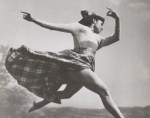
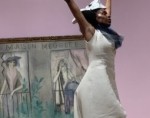
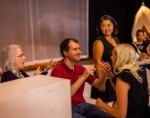
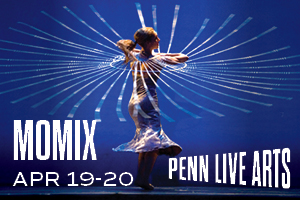
.png)


